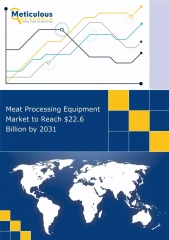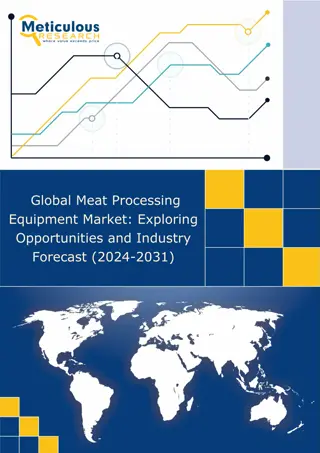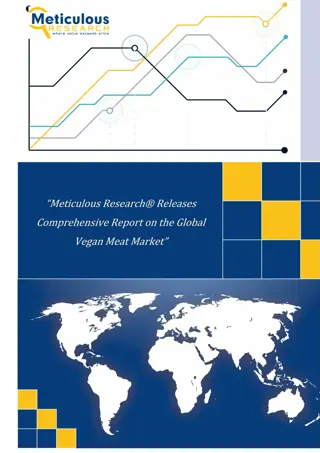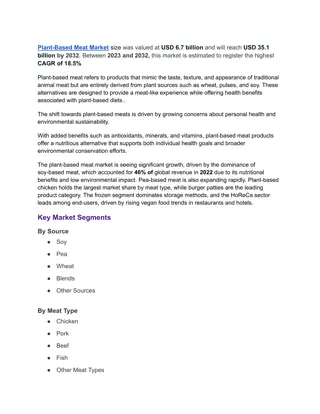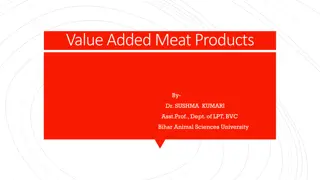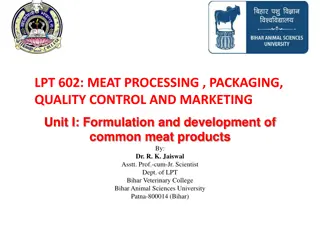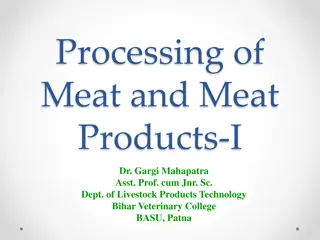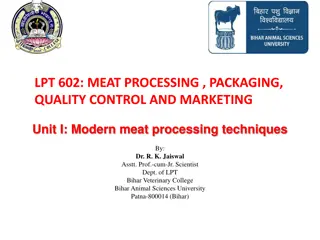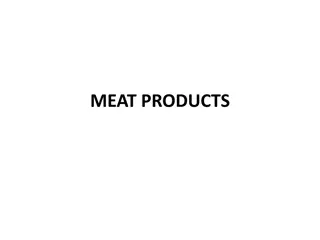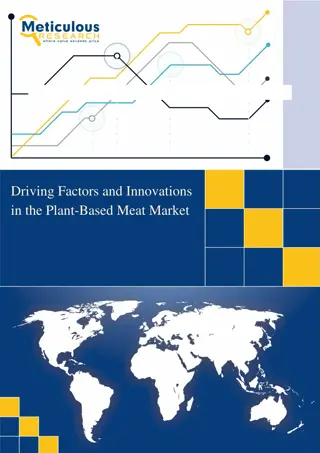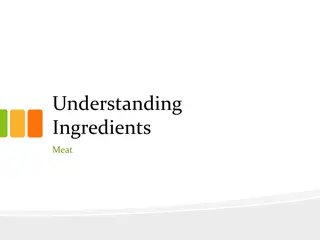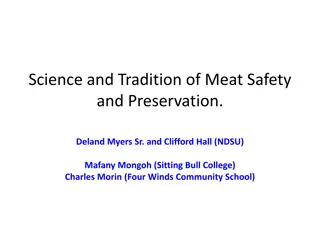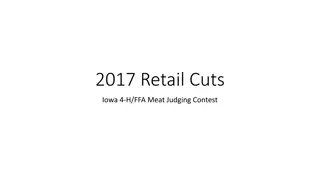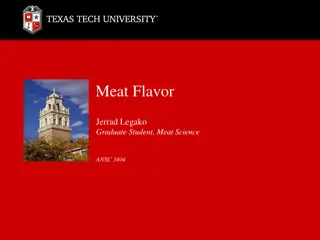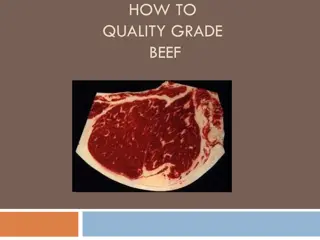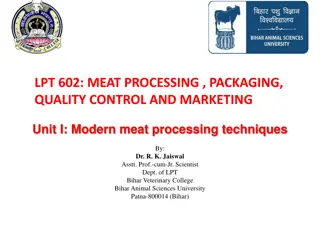Overview of Meat Industry Prospects in India
The meat industry in India holds significant prospects with a large livestock population, ranking high in goat, buffalo, sheep, and cattle numbers globally. The country has seen developments in modern abattoirs and meat production statistics. Animal food is noted for its high-quality nutrients compared to plant food. Challenges persist, including limited corporate involvement in the meat business.
Download Presentation

Please find below an Image/Link to download the presentation.
The content on the website is provided AS IS for your information and personal use only. It may not be sold, licensed, or shared on other websites without obtaining consent from the author.If you encounter any issues during the download, it is possible that the publisher has removed the file from their server.
You are allowed to download the files provided on this website for personal or commercial use, subject to the condition that they are used lawfully. All files are the property of their respective owners.
The content on the website is provided AS IS for your information and personal use only. It may not be sold, licensed, or shared on other websites without obtaining consent from the author.
E N D
Presentation Transcript
Prospects of Meat Industry in India Dr. R. K. Jaiswal Asstt. Prof.-cum-Jr. Scientist Dept. of Livestock Products Technology Bihar Veterinary College Bihar Animal Sciences University Patna-800014 (Bihar)
Livestock Resource largest India livestock population, 55% and 16% of the world s buffalo populations, respectively has the and cattle The country ranks first in goat and buffalo, second in sheep and cattle, and eighth in populations in the world. poultry
20th Livestock Census (DAHD, 2019) ALL INDIA LIVESTOCK CENSUS (in million) 2007 2012 2019 Category % Change (2012 to 2019) 0.85 1.06 -25.00 26.66 1.00 14.13 10.14 -45.24 -57.09 -61.23 -37.05 -12.03 4.64 Cattle Buffalo Yak Mithun Bovines Sheep Goat 192.52 109.85 0.06 0.38 302.82 74.26 148.88 0.34 0.08 0.12 0.25 9.06 535.82 199.08 105.34 0.08 0.26 304.76 71.56 140.54 0.61 0.14 0.44 0.52 11.13 529.70 190.9 108.7 0.08 0.30 299.98 65.07 135.17 0.63 0.20 0.32 0.4 10.29 512.06 Horses & Ponies Mules Donkeys Camels Pigs Total livestock
Meat Production statistics Production of meat (All India) Species wise meat contribution in 2018-19
Percentage share of meat producing states in 2018-19
Animal Food vs. Plant Food Animal food is considered as good source of quality nutrients viz. fat, protein, carbohydrates and minerals. Digestibility of animal source protein is 90-97% while vegetable origin proteins have 75-99%. Proteins of animal origin are more completely digested and nutritionally superior than those of plant origin. Plant origin proteins are deficient in at least one or more essential amino-acids. Some cereals in lysine and some legumes in methionine but the animal proteins contain all essential amino acids.
Development of the Meat Industry During the last decade, ten modern abattoir complexes have come up in public and private sector. Eight new modern mechanized abattoirs were initiated in 1990- 91. In the VIII Plan, five private sector export abattoirs were completed. Allanasons, Alkabeer and Hind Industries - major export houses. Industry - handful of business houses in SME sector dominated by a religious group. Large corporate houses did not venture in this business at all.
An attempt was made by Brooke Bond in 1970s when they set up a large modern processing plant for export with a throughput of 500 buffaloes per day at Aurangabad Maharashtra. The plant had facilities to handle by-products. The project failed mainly for three reasons Non availability of buffaloes to run at capacity everyday, Higher cost of production and therefore difficulty in marketing the same and Marketing problems of by-products The plant was finally sold to Allanasons, who sell through their own retail outlets in Middle East. Therefore they importer of their own output to a large extent. They thus control the market.
Trends in meat production and processing Although India has been the top producer of milk (>187.7 million tonnes), which is one of the primary produce of the livestock sector, the meat production is only 8.1 million tonnes annually representing mere 2% of the world production. Nearly four million tonnes of poultry meat was produced in India for 2018-19. The domestic market is mostly confined to fresh meat because of the eating habits of the Indians.
Of the total meat produced, 90% processed at home, only about 2% is converted into value added products like sausages, ham, bacon, kababs, meatballs, etc. and remaining 8% is exported Buffalo meat production was 1.54 million tonnes in 2018-19 and is expected to increase. The growth is primarily due to increasing domestic consumption, growing exports and a new trend of salvaging male buffalo calves for meat production.
Export of Animal Products for 2018-19 (APEDA) CATEGORY Buffalo Meat Sheep/ Goat Meat Poultry Products Dairy Products Animal Casing Processed Meat Albumin (Eggs & Milk) Natural Honey TOTAL Value (in crores Rs.) 25168.31 790.65 687.31 2422.85 480.66 13.52 103.06 732.19 30,632.81
The buffalo meat share in total meat exports from India is more than 80 percent (in value terms), followed by 3% per cent share of goat and sheep meat and the rest comprising of poultry meat and animal casings. The country has exported 12,36,638.39 MT of buffalo meat products to the world for the worth of, Rs. 25168.31 Crores during the year of 2018-19. Major Export Destinations for buffalo meat (2018-19) : Vietnam Soc Rep, Malaysia, Indonesia, Iraq and Myanamar. Exports of other types of meats such as from pork, poultry, and processed meat are almost negligible due to higher costs, inadequate meat processing facilities, and infrastructure constraints.
For exports mostly deboned frozen buffalo meat is used. The demand for bovine meat has increased over the years in the global markets resulting in higher prices of cattle meat. This has opened new opportunities for us and led to increase in buffalo meat exports from India in recent years (BLACK GOLD). Slaughter rate for cattle as a whole is 20%, for buffaloes it is 41%, pigs 99%, sheep 30% and 40% for goats. In India there are about 3,900 licensed & authorized slaughter houses besides around 26,000 unauthorized slaughter houses.
Furthermore, there are 13 export-oriented, modern, integrated abattoirs or meat processing plants registered with APEDA. In addition to these, there are 24 meat processing and packaging units, which receive dressed carcasses from approved municipal slaughter houses for the export of meat.
Status of Poultry Industry in India Poultry is one of the fastest growing segments of the agricultural sector in India today. While the production of agricultural crops has been rising at a rate of 1.5 to 2 percent per annum, that of eggs and broilers has been rising at a rate of 8 to 10 percent per annum. According to the Ministry of Food Processing Industries (MOFPI), about 70% of poultry processing is in the organised sector and 30% is in the unorganised sector. Nearly 60-70% of the broiler industry is located in the southern states, as is much of the layer industry.
The total poultry population in the country is 851.81 million in 2019. The total poultry population in the country has increased by 16.8% over the previous census (DAHD, 2019) The total Backyard Poultry in the country is 317.07 million in 2019, increased by 45.8% over previous census. The total Commercial Poultry in the country is 534.74 million in 2019, increased by 4.5% over previous census. Nearly four million tonnes of broiler meat and about 103.32 billion of eggs are produced annually in India.
Five major players (Suguna in Coimbatore, Venkys in Pune, CP, Sneha, and Shalimar in Kolkata) constitute 60 per cent of the broiler meat market. The average live weight of 1.8-2.2 Kg. Broiler meat production has been growing in India at a rate of 7-8 per cent. Over all, Andhra Pradesh counts for maximum egg production and Hyderabad is the city with maximum poultry and hatcheries.
Indiasper capita consumption of broiler meat just 3.35 Kg per person per year as compared to 45 Kg in Brazil, 43 Kg in the United States, 34 Kg in South Africa, 31 Kg in Canada, 10.5 Kg in China, and 6.5 Kg in Indonesia, and 17 Kg for the world. The National Institute of Nutrition has recommended 180 eggs and 11 kg of meat per capita consumption for our country India is now the world's third largest egg producer and the sixth largest producer of broilers.
The country has exported 5,44,985.06 MT of Poultry products to the world for the worth of Rs. 687.31 Crores during the year 2018-19. Major Export Destinations (2018-19): Oman, Maldives, Japan,Vietnam Soc Rep & Indonesia. India's poultry product exports are mainly confined to eggs and egg powder, which are growing due to cost competitiveness and logistical advantages. There are no restrictions on exports of poultry and poultry products.
Ministry of Fisheries, Animal Husbandry and Dairying, GOI It is a newly formed ministry in May, 2019 by present government from the department of same name under Ministry of Agriculture and Farmers Welfare. It consists of two departments: 1. Department of Animal Husbandry and Dairying (AH&D) 2. Department of Fisheries Name Designation Hon'ble Minister of Fisheries, Animal Husbandry and Dairying Hon'ble Minister of State of Fisheries, Animal Husbandry and Dairying Shri Giriraj Singh Dr. Sanjeev Kumar Balyan Hon'ble Minister of State of Fisheries, Animal Husbandry and Dairying Shri Pratap Chandra Sarangi
Animal and Fisheries Resource Department, Govt. of Bihar Name Dr. Prem Kumar Designation Hon'ble Minister of Animal and Fisheries Resource Department, Govt. of Bihar Secretary, Animal and Fisheries Resource Department, Govt. of Bihar Dr. N. Saravana Kumar APEDA: Development Authority (New Delhi) MPEDA: Marine Products Export Development Authority (Kochin) FSSAI: Food Safety and Standards Authority of India (New Delhi) Agricultural and Processed Food Export


